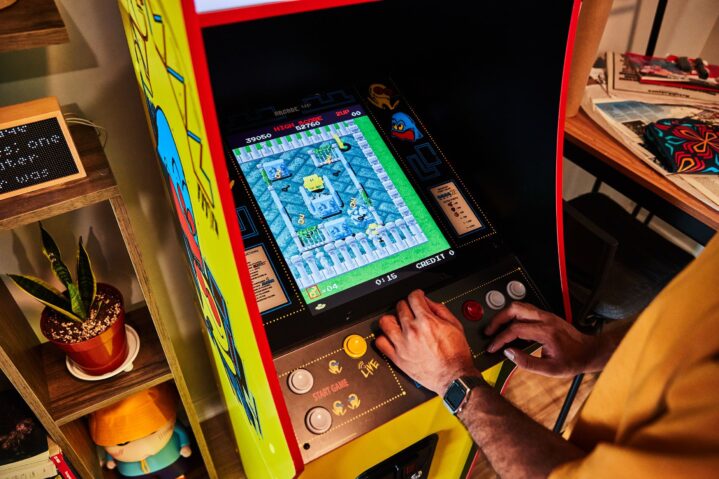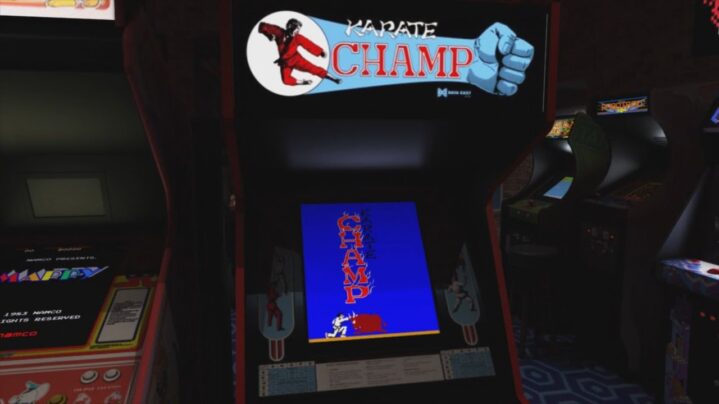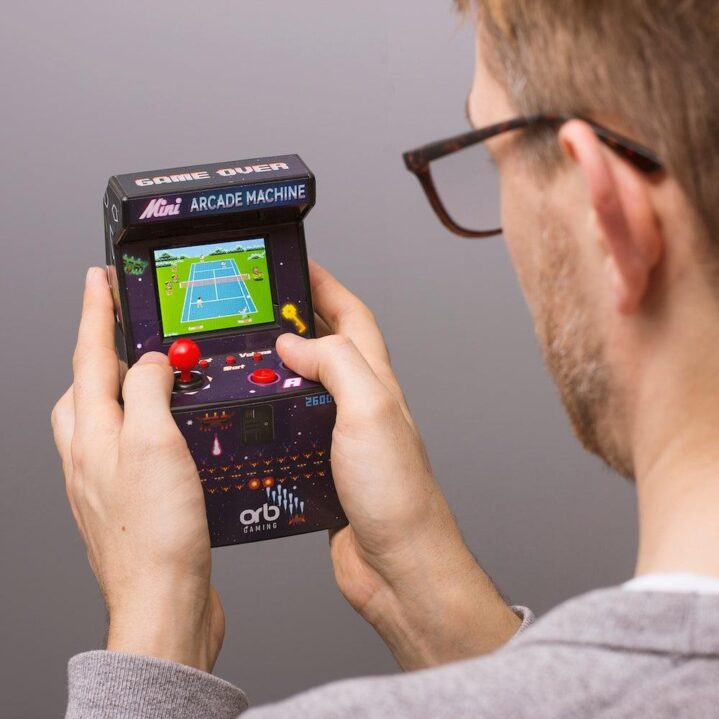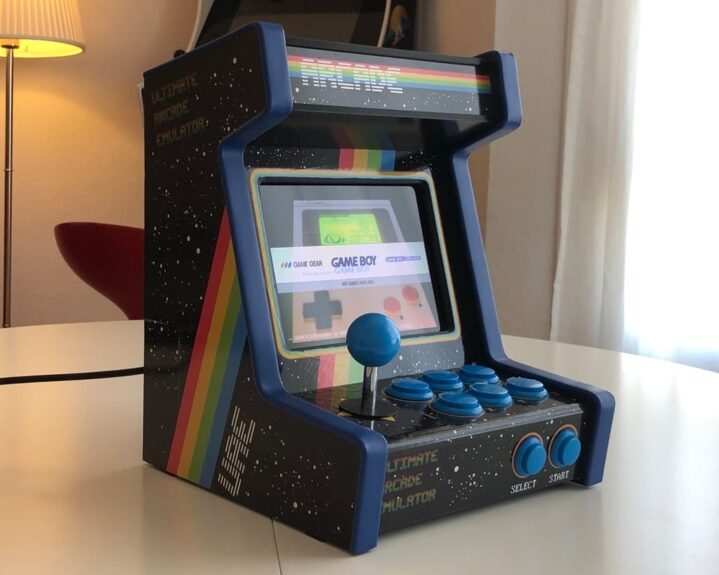Let’s set the scene. You’re in your room. In the corner, something is glowing. It’s got a joystick. Maybe a couple of chunky red buttons. And on that little screen? Frogger’s trying to cross the street like his life depends on it. That’s because it does. Welcome to the world of mini arcade machines.
We’re not talking about the plasticky toy things with weird lag and mushy buttons, but real mini arcade machines; shrunken-down versions of the real deal. The kind you can keep in your room, on a shelf, maybe even next to your bed. Some of these are so good, it’s like the arcade followed you home and politely asked for a corner of your life.
The Machines that Actually Feel Like Machines

Let’s start with one of the heavy hitters: the Arcade1Up Counter-Cade series. If you’ve spent even five minutes down a retro gaming rabbit hole on YouTube, you’ve seen these. These are mini cabinets with real weight to them, both physically and emotionally.
They come preloaded with classics like Pac-Man, Ms. Pac-Man, Galaga and Dig Dug. The joysticks have proper resistance and the buttons make that glorious clack sound, while the bezels are spot-on replicas of the original artwork.
If you want the feel of a 1982 arcade without needing to knock out a wall in your apartment, these are the ticket. And they’re not just for looks – you can genuinely spend hours chasing high scores and falling into the zone. You’ll die a hundred times in Galaga before you even realize you haven’t blinked once in 10 minutes.
Next up is the My Arcade Micro Player line. These are smaller – more like the height of a tall mug than a full cabinet – but still surprisingly playable. You’ll find titles like Bubble Bobble, Bad Dudes, BurgerTime, Karate Champ and even Heavy Barrel in the lineup.
The screens are bright, the controls are responsive and they look slick on a shelf. You’re not going to run a speedrun marathon on one, but they’re perfect for a mid-scroll distraction when your phone just isn’t doing it any more.
Now, let’s talk about the elite tier: New Wave Toys’ Replicade series. These are for the detail-obsessed. These machines are 1/6 scale recreations of the original

arcade cabinets, built with real wood trim, die-cast metal parts and even coin slots that light up.
Games like Dragon’s Lair, Centipede, Street Fighter II: Champion Edition and Asteroids feel like they were lifted straight from the past and dragged into the 2020s. Yes, the controls are small, but they’re arcade quality. The screen clarity is astonishing. These are conversation pieces you can actually play, and they belong on any shelf that values vibe over practicality.
And then there’s AtGames’ Legends Ultimate Mini and Core Max for people who want variety. These don’t go all-in on the nostalgia aesthetic, but they pack hundreds of licensed titles, from Aladdin to Space Invaders.
Some models even connect to online leaderboards or let you sideload games. These are more about casual fun, but that’s the beauty of it; just fire it up and dive into whatever you’re in the mood for.
Build It Yourself

But what if none of those machines scratch your very specific itch? Maybe you want Samurai Shodown II, or you want a wooden cabinet that matches your bookshelf, or you just like building stuff? That’s when you get into the world of DIY arcade builds.
Start with a Raspberry Pi and load up RetroPie or Batocera. Add a small HDMI screen, some arcade buttons, a joystick and a power source. Put it all in a custom case. It can be wood, acrylic, an old toolbox, a metal lunchbox, whatever your imagination can come up with. With a little effort and some creative recycling, you’ve suddenly got a one-of-a-kind arcade cabinet.
Want to go deluxe? Add LED lighting, better speakers, a rechargeable battery and a save/load system, or go low-budget by skipping the screen entirely and plugging your Pi into your TV with a USB arcade stick. Either way, you’ve basically built your own time machine!
Why They Belong in Your Room
Let’s talk space. Mini arcade machines are, obviously, mini. But that doesn’t mean they’re background noise. They own their space. They sit there like little monuments to joy.
That’s why they’re perfect for your room. Your room isn’t just where you sleep or doomscroll; it’s your reset zone. Your soft-launch pad for whatever comes next. And when you’ve had a day full of meetings, errands, meetings about errands, bad news and worse group chats, sometimes the most healing thing is to hammer a joystick for 10 minutes and shoot space bugs until your mind goes quiet.
These machines remind you how to just play – and there’s something comforting in that simplicity. A Pac-Man machine doesn’t care what you look like, what you do for work, how well you cooked dinner or what your Twitter bio says. It just asks: can you survive this maze?
Arcade Games and Slot Machines

There’s a reason people often compare arcade machines to slot machines. Both suck you in with light, sound and pattern. Both rely on unpredictable payoffs. Both light up the same little parts of your brain that love rhythm and reward. The similarities don’t stop there; both have left the constraints of the cabinet behind and filled every niche possibly imagined.
Online casinos tap into this interest with hyper-modern video slots that go far beyond the old “pull the lever” routine. But with more variety comes more confusion, especially for new players.
That’s where review sites come in, offering detailed guides to help players navigate their options. How detailed? AskGamblers.com, an award-winning iGaming site, recently published a guide specifically for Michigan-based players. It may seem niche, but with laws and availability varying by state, resources like this help players find the best legal choices.
Whether you’re smashing buttons on a Donkey Kong cabinet or spinning the reels at a West Virginia casino, you’re looking for the same thing: entertainment, fun and a temporary distraction.
A Little Bit About the Past, a Lot About Right Now
There’s a lot of nostalgia involved with these arcade beauties. You get one of these machines and suddenly you’re 12 years old, drinking a neon slushie and waiting for your turn at Double Dragon. But mini arcade machines aren’t just souvenirs from the past. They’re tools for surviving the present.
They don’t demand logins. They don’t push updates. They don’t sell you expansions or data mine your habits. You plug them in and they work. And in a world that’s always online, always updating, always asking something from you, these machines ask for just one thing: your attention.
That’s why people put them in bedrooms, from grand Brooklyn apartments to back rooms in Charleston. It’s not really about gaming. It’s about access to joy.
